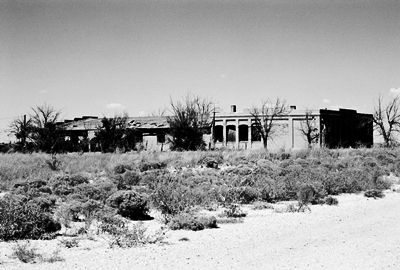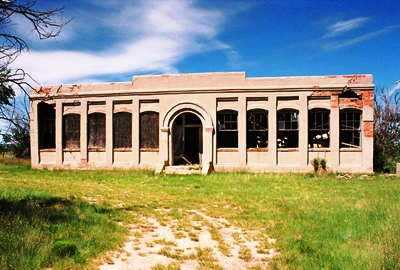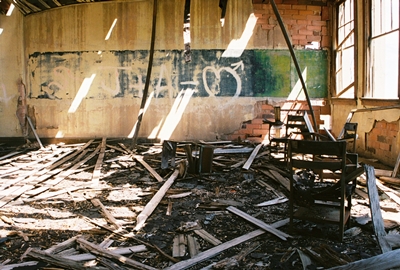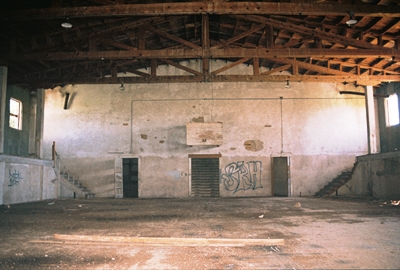
Let’s stay in central New Mexico for one more post and add yet another piece to the picture of a region that in the 1920’s was the country’s largest producer of pinto beans. While you probably aren’t going to drive through without reason, as you might Mountainair, nor are you going to find it in most ghost town guides, as you will Claunch, Cedarvale was an important dry land farming and ranching community from the time of its establishment in 1908 until the Dust Bowl and Great Depression combined, along with overgrazing and farm consolidation, to force many of its residents to search for their fortunes elsewhere…yet again.
It was Ed Smith, William Taylor, and Oliver P. DeWolfe who chose the site for Cedarvale and requested that it be surveyed by the U.S. government. The town would be along the route of the New Mexico Central Railroad. Lots were sold through the General Land Office and a post office was soon opened. The new place was named Cedarvale after Cedar Vale, a town in Kansas from which the founders hailed and was also located in a valley with cedars (i.e., junipers).

Soon hundreds of homesteaders from other states arrived on “immigrant trains,” following the lead of Smith, Taylor, and DeWolfe. Most were looking to plant pinto beans. The relatively high altitude (6,384 ft) and short growing season of central New Mexico was good for the beans, which could be dry farmed and were in demand, particularly once World War I began and pinto beans were used to feed soldiers. Come fall, the harvest was stored in Cedarvale’s three elevators.
The population of Cedarvale would eventually reach about 500, but is now perhaps half that, and there are no functioning commercial concerns. The post office closed in 1990. But what impresses one most as they approach from the northwest along Highway 42 is the looming wreckage of the Cedarvale School. Initially, the school in Cedarvale was a typical one-room affair, but as both the town and Torrance County grew more space was needed. So, Oliver DeWolfe donated 20 acres of land and, on August 25, 1917, the Torrance County Board of Education approved a bond issuance in the amount of $5,000.00 to construct a new school.

The school was finished in 1921 and an addition made in 1935 via the Works Progress Administration (WPA). By then, the building seems like it would've been surprisingly big for the area, containing four large classrooms, each of which contained three grades and about fifty students. Children attended kindergarten through eighth grade and were then driven in the back of a truck a few miles southeast to Corona for high school. No fancy Bluebird busses here!
Aside from continuous and dire warnings about rattlesnakes, the massive gymnasium remains perhaps the most striking feature of the Cedarvale School. This was clearly a gathering place for the entire community, as well as a basketball court (complete with raw wooden backboards still in place) and, judging from the design, probably a theater. I’ve heard it hosted some bingo games, too. Despite taking the warnings fairly seriously—signs are even painted on the walls of the school—no rattlesnakes were encountered on this trip.

The school closed in 1953 and is now falling down quickly, the years finally overcoming its sturdy construction. The large wooden beams are impressive, and I’m told the Cedarvale train depot was built to the same hardy specifications. The depot no longer stands, but the materials were re-purposed and used in a home in Albuquerque which is owned by the daughter of a man who helped build both the depot and the school. I’m pleased to have been able to walk around on that historic lumber recently!
There are still many people that have fond memories of growing up in Cedarvale, as is true for virtually all the small central New Mexico towns in which the train once rattled through constantly and the whoosh of pinto beans pouring from the elevator heralded the end of one season and the approach of the next. These are sounds which may yet perhaps be heard, if only faintly, in the startling quiet of places like Cedarvale.

As I said, there ain’t much out there on Cedarvale. David Pike’s “Roadside New Mexico: A Guide to Historic Markers” has a good synopsis of the town’s founding and the history of the school. You can glean a little bit more from “The Place Names of New Mexico” and its similarly-named predecessor, “New Mexico Place Names: A Geographical Dictionary.” Beyond that, you’ll have to hope that maybe someone that was there will tell you what it was like.
Awesome post as usual John!
ReplyDeleteI had driven many times past Cedarvale on the way from Alamogordo to Albuquerque (and back) on Hwy 42 where it starts at Corona and ends at Willard. Nearby (in NM terms) are the Salt Mission ruins, which would be worth a post. As I was just passing through, I never had time to explore the old school.
ReplyDeleteIt’s a beautiful, lonely drive, day or night, as only New Mexico can offer. Your post prompted me to look it up on Google Maps and the satellite view. It looks different from the early ‘60s road maps I used to navigate around NM. I used the older maps because they showed a number of roads that no longer exist or are maintained. Thanks for the post, it brings back a lot of solo trips across central NM 20 years ago. In a sense I am relieved that it’s not all gone, just yet. Thanks for another trip down memory lane.
Thanks very much, Atsf Roswell! Glad you enjoyed it! JM
ReplyDeletePost scriptum (you know how I like to run on)
ReplyDeleteI think people have forgotten how important the railroads were in NM. The ability to get somewhere along the line, despite poor roads and bad weather conditions was a huge plus for distant and remote communities in NM for both passengers and freight along the line. When the railroad went away, communities lost a powerful asset in the struggle for survival.
A good article would be to string together your previous postings about ghost towns along the NMCR and other important railway routes such as the east-west El Paso and Southwestern RR from El Paso to Douglas are dotted with ghost towns. Some good links on the subject follow. Hopefully some of this will be of interest to your readers
http://www.dot.state.nm.us/content/dam/nmdot/Travel_conditions/maps/rail_map_dV9_3.pdf
http://www.american-rails.com/support-files/new-mexico-railroad-stations.pdf
http://www.abandonedrails.com/New_Mexico_Central_Railway
http://www.abandonedrails.com/New_Mexico
https://en.wikipedia.org/wiki/List_of_New_Mexico_railroads
link for books on NM rails http://abclibrary.org/railroads
https://en.wikipedia.org/wiki/El_Paso_and_Southwestern_Railroad
A powerful resource for old RR maps is the Library of Congress http://www.loc.gov/teachers/classroommaterials/connections/railroad-maps/file.html
Antique maps for sale http://www.mapsofthepast.com/old-railroad-maps-new-mexico.html
Those are some wonderful links, CoastConFan! Thanks! I especially liked Surviving New Mexico Railroad Stations (link two). I'd never seen that before and there are some depots I've tried to track down over the years. These would include the Lucy and Yeso depots, although they have Yeso listed as being in Vaughn when I believe it's on a ranch in Corona, New Mexico.
ReplyDeleteSpeaking of Yeso, that's a good example of a real NM railroad town. I did a post on Yeso a few years ago, which can be seen HERE. Of course, VAUGHN would be another. I also did a FAIRLY LONG PIECE on the AT&SF Rail Yards here in Albuquerque, my favorite collection of industrial buildings anywhere by far. The location of the rail yards is a big part of why Albuquerque is as it is. And where it is. And to think the complex is largely abandoned. I've even got an ENTIRE ALBUM of photos of the rail yards on Flickr.
I'd really love to combine all my various NM railroad ghost town pieces into a coherent whole, but I'm afraid that will have to wait for a bit. I can barely get anything written at all these days!
As for the Salt Mission ruins, I hope to do a post on them, too...eventually. I've been to all three--Abo, Gran Quivira, and Quarai--multiple times. But so far I've only GOT PHOTOS to show for those trips.
Finally, when it comes to the history of trains and the Southwest, I have to mention the excellent RAILS WEST blog, whose engineer commented as Atsf Roswell above.
Anyway, thanks again, CoastConFan. Sorry the posts have been so few and far between lately! I hope to do better in 2016! JM
Here is another interesting book, ""Ghost Town Basketball: Former High School Teams of New Mexico" by Steve Flores". I first read it at a small local restaurant in ABQ. It is another source of info for these small towns.
ReplyDeleteSpeaking of railroads, have you been to Gilman Tunnels off NM485? Some friends of mine lived in the old logging camp in 1978. I think the remnants of the lumber mill are still down along the Rio Guadalupe.
deicher, "Ghost Town Basketball" does indeed sound very interesting. Unfortunately, the only copy on AMAZON is currently at $101.23. Hmm. Well, I may have to keep my eyes open for something in the two-digit range. Thanks for the tip!
ReplyDeleteAs for Gilman Tunnels, it's odd but...I've never been through them. I've only driven NM 4 up that way. I really do need to check out that stretch of NM 485. Maybe I'll go up this spring and take a look for those lumber mill ruins. I have been to SODA DAM though! JM
Thank you for sharing! My husband and I happened on Cedarvale a few months ago on a trip from Alamogordo to Albuquerque. We like discovering new roads and by chance stopped to stretch at Cedarvale. Much to my chargrin, my husband felt it necessary to discourage me from wandering inside the beautiful, but derilect school house. The old stove and chalkboards on the walls were a neat surprise! Stumbling upon old, forgotten buildings is something I cherish on our road trips and it's great to find people with a common interest! - A 30-Something Wanderlust Heart
ReplyDeleteI really enjoyed learning the history of Cedarvale. My grandson and I took a trip to White Oaks just because. On our way back to Albuquerque, we stumbled upon the schoolhouse. The roof is completely caved in but it was a really awesome find.
ReplyDeleteThanks, WanderingNM1970! "Just because" is a great reason to visit White Oaks! And the Cedarvale school *is* an awesome find. I'm sorry to hear that roof has caved in so badly though. It was in better shape when I first visited, but it was clear then that collapse was inevitable.
ReplyDeleteAlso, I've included Cedarvale in "Abandoned New Mexico: Ghost Towns, Endangered Architecture, and Hidden History," due out on August 24. More info is HERE.
Thanks for stopping by! JM